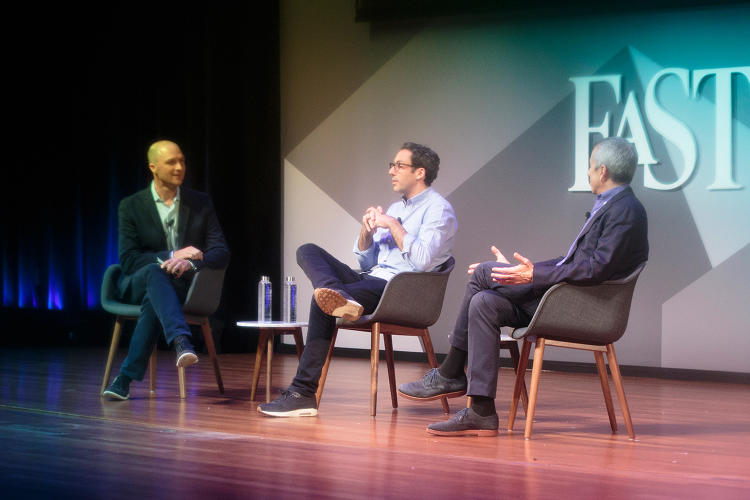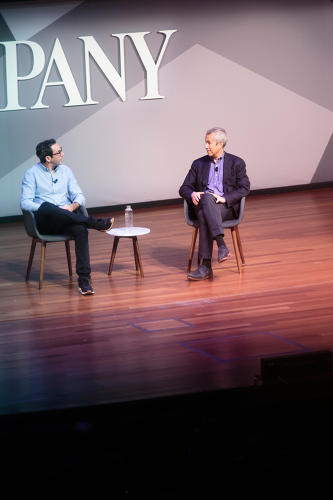Valuable Customer Interactions Are Data-Driven, But Always Human
Technology should be like a good butler: present when needed, but invisible when not. These days, though, technology often gets in the way of human interaction, especially when it comes to hospitality (think automated phone systems).
Neil Blumenthal, cofounder and co-CEO of Warby Parker, and Danny Meyer, Union Square Hospitality Group’s founder and CEO, know something about this. They have built their careers on their ability to meld data and people to ensure great customer experiences. Here’s what they revealed during Fast Company’s Innovation Festival in New York City earlier this month.

Technology As An Assist
“We’re not trying to take humans out of the equation,” Meyer said. “It’s about how can you empower people with technology.”
As an example, Meyer said the managers in his restaurants will soon wear Apple Watches to display relevant customer data—like alerts when customers enter the restaurant or are seated.
“The reservation app Resy worked with Union Square Hospitality Group’s IT department to customize it,” Meyer said.
Amplify High-Value Interactions
Blumenthal said he and his three cofounders were unsuccessful in their search for a point-of-sale system that included all the features they wanted, so they built their own program from scratch. They call it their “Point of Everything” system. It runs on iPad minis, which customer service employees carry around the store to help shoppers and carry out transactions.
“One of the things we want to do is eliminate low-value interactions and amplify high-value interactions,” Blumenthal said. “So us asking someone for their billing address, that’s a low-value interaction and, frankly, something you’d prefer not talking to a human being about. Selecting the right pair of glasses for your face and feeling confident in that decision—that’s something we want to engage with.” In other words, technology can’t replace a real person giving you real advice about what looks best on your face.
The Value Of Data
Meyer says customer service-driven businesses should always be gathering information on customers. “Always be collecting dots so you can always be connecting dots,” Meyer said. For example, he wants loyal customers to feel special even if the staff doesn’t recognize them; data in the restaurant’s booking system can make sure employees always know which customers are most important. As Meyer put it, “If that maitre’d happened to be off that day, what happened to my preferred customer status?”
Meyer understands this well. He has focused on customer experience his entire career as a restaurateur, starting with his first restaurant: the Union Square Cafe in New York City, which he opened in 1985 at the age of 27. He now owns numerous restaurants, many of them among the most loved in New York. They include Shake Shack, Gramercy Tavern, Blue Smoke and Jazz Standard, The Modern, Cafe 2, and Terrace 5 at MoMA.
Personalized Attention
Warby Parker’s customer experience team members (aka “CXs”) are also looking for “dots.” Blumenthal recalled a day when a Warby CX was live-chatting with a customer when the customer made a few Lord of the Rings references. The CX, however, wasn’t a Tolkien fan, so he went and found another CX who knew the right lingo and had that agent talk to the customer.
When Warby Parker picks up on these hints at a customer’s personal taste, Blumenthal said, they can sometimes use them to strengthen the customer bond. For instance, he said, Warby Parker might send the Lord of the Rings fan a gift related to the movie.
Social Media Makes Or Breaks You
Both Warby Parker and Union Square Cafe are very sensitive to social media as a way of finding new data points on customers and are very aggressive about responding to complaints.
Twitter in particular, because of its real-time quality, can have a big impact on the perception of any consumer-facing business, both good and bad. It’s where many people first think to go to complain about a disappointing experience. “When someone is sitting at the table tweeting, they’re basically having dinner with all those people, all their followers,” Meyers said.
But they also go to Twitter to rave about a great experience. “So what you want to do is pour gasoline on the good fires and tamp down the bad ones,” Meyer told me after the panel.
Meyer said sometimes the reason people complain on social media is that they actually like the restaurant, but they were let down. When something like this happens, Meyers said he’s often mentioned personally in the tweet, along with the name of the restaurant. That’s when he places a call and instructs the manager or the maitre’d or the chef (or “whoever is around,” Meyer said) to visit the table, address the customers by name, and do what it takes to turn the situation around.
If the retailer handles negative tweets and posts well, complaints can sometimes be spun into marketing opportunities. Blumenthal tells the story of one of his customer experience reps, “Tim,” who helped a client so often and so well that she eventually made him a video (below) as a way of saying thanks. The video ended up going viral and racking up 30,000 views.
Why Data Matters
What customers really want is to feel like a product or service is being created just for them. And a rich personal data set can be the secret sauce that allows the retailer to deliver that personalization.
“I hate to say it, but we are all selling a commodity,” Meyer said. “My chefs would be furious if they hear me say this, but whatever we cook you can find it elsewhere—what you come back for is the way it made you feel.”
Fast Company’s Noah Robischon (far left) with Neil Blumenthal and Danny Meyer.





Fast Company , Read Full Story
(33)







